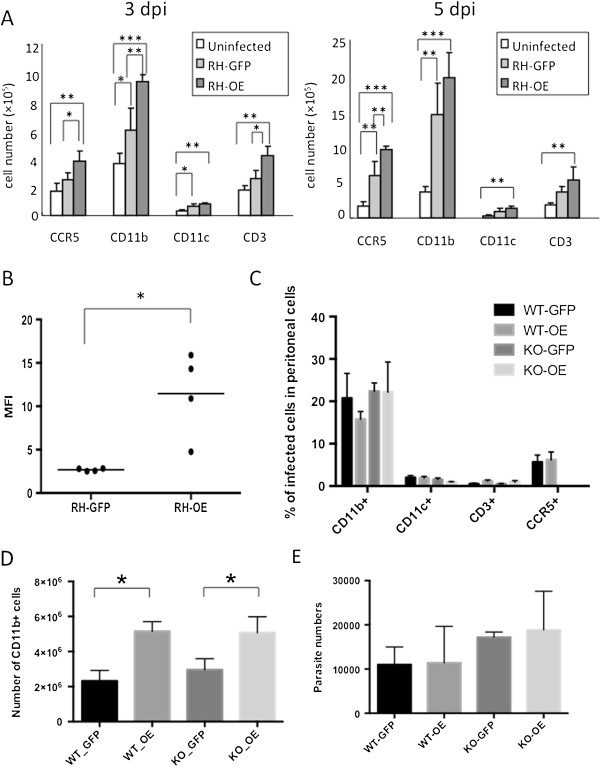Figure 3.
Immune cell recruitment and parasite infections. (A) Wild type (WT) mice were infected intraperitoneally with T. gondii tachyzoites. Peritoneal cells were harvested from uninfected or parasite-infected mice at 3 and 5 days post-infection (dpi). Cells were then subjected to flow cytometry to determine the absolute number of cells expressing CCR5, CD11b, CD11c, or CD3. Each value represents the mean ± the standard deviation of four replicate samples. (B) CCR5 expression levels in peritoneal cells at 3 dpi. WT mice were infected intraperitoneally with T. gondii tachyzoites. CCR5+ and GFP+ host cells were detected using flow cytometry and the mean fluorescence intensity (MFI) of CCR5 expression was determined. Infection rates for RH-GFP and RH-OE were 50.9 ± 5.4% and 50.4 ± 4.1%, respectively. Bars represent the average for each experimental group (n = 4). (C) Peritoneal cell infection rates. WT and CCR5−/− (KO) mice were infected intraperitoneally with T. gondii tachyzoites. At 5 dpi, peritoneal cells were subjected to flow cytometry to determine the number of GFP+ host cells. Each value represents the mean ± standard deviation of four replicate samples. (D) WT and KO mice were infected intraperitoneally with T. gondii tachyzoites. At 3 dpi, peritoneal cells were collected and the number of CD11b+ cells was measured. Each value represents the mean ± the standard deviation of four replicate samples. (E) Real-time PCR quantification of parasites in the peritoneal cells of WT and KO mice at 5 dpi. Each value denotes the number of parasites in 50 ng of DNA and represents the mean ± the standard deviation of four replicate samples. RH-GFP (GFP): parasites transfected with GFP alone; RH-OE (OE): parasites transfected with TgCyp18HA and GFP. The results are representative of two repeated experiments with similar results.

